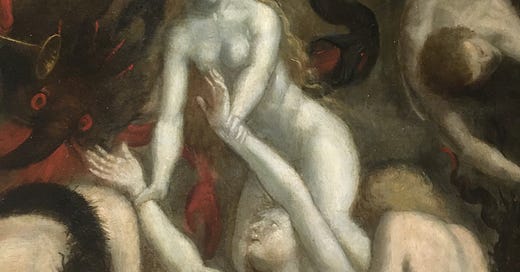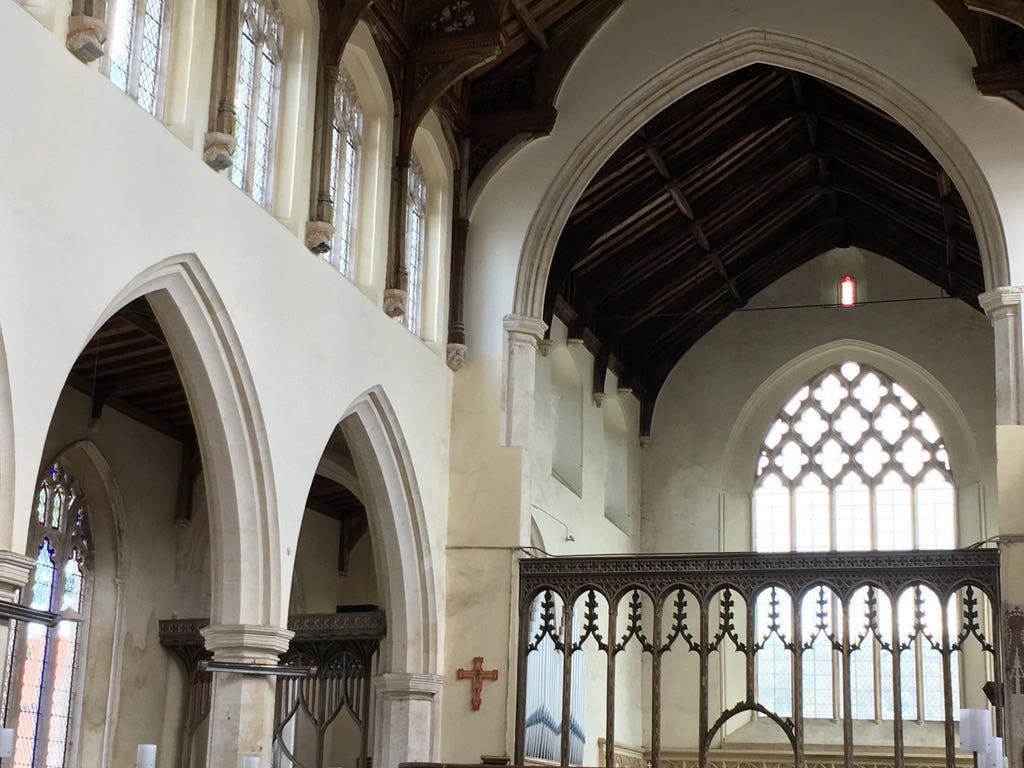Wood and the Canon
Canon-bashing is usually done on the basis of the people who are excluded. In this newsletter, I spare a thought for an inanimate material
The ‘culture wars’ plough on—definitely in the trench-warfare stage at this point. It is a tedious, pointless, and largely manufactured controversy between two sides of the journalistic editorial slant. It is weird, boring, and it doesn’t seem to go away.
Accurate depiction of Telegraph and Guardian readers writhing together in equal agony for their sinful indulgence in the early 21st century culture wars.
One of the battlegrounds of the culture war is the cultural canon. This, for recap, is the collection of artists, musicians, and so on, which are considered to be worthy of study. More importantly, their historical position gives them a level of reverence. This is where the problems begin. If we revere a historical figure, what about them do we revere? What does that say about us? Do we just like Eric Gill’s typeface thank-you-very-much, or does our fondness for his take on sans serif say something about our ability to ignore the very bad things he did in his lifetime?
Alternatively, our worry might be that we are venerating particular artists at the expense of others. The reputation of artists was often formed in a very different context to our own, where large blankets of society were not given a look in because of the powerful grip of prejudice and its consequences. Do we seriously think that Juan de Pareja (born into slavery) competed on a level playing field with Diego Velazquez (born to a lawyer)?
I’m not interested in these well-trodden but hard-to-resolve grounds for this newsletter. Instead, I’m interested in making matters worse. I want to add fuel to the fire by pointing out a completely different and arguably weirder predicament. What if our bias doesn’t stop at real human beings in art and cultural history. What if we’re even biased against inanimate objects? Specifically, what if we’re biased against raw materials?
There are a number of materials that one might think of which have gotten a bad press. Textiles are one which are associated with human prejudice due to the supposedly ‘feminine’ nature of the medium. The irony is that textile-based artworks were among the most expensive and revered in medieval and early modern Europe. In that context, I don’t think tapestry has favoured so badly—until now.
I want to deal with a different case where the material in question doesn’t have any obviously gendered or racialised properties at all. That material is wood.
As many readers will be aware, wood is dead matter which literally grows on trees. It is therefore a biological product, sensitive to climatic conditions. These climatic conditions have massive ramifications on what can be made in any given place. They determine the type and quantity of wood which is available. All wood, in addition, is conditioned by the fact it grows on trees to the extent that it tends—with some exceptions known as branches—to grow upwards. This means wood has a grain. Problematic things happen when you work against the grain. It will give you RSI, it will look terrible, and it will damage your tools.
All of these features of wood are taught at secondary school level in the United Kingdom. They are excruciatingly basic—and I have underscored this by writing about it as patronisingly as possible. And yet, the absence of wood from canonical art historical courses is deafening.
For my BA, I studied the history of art at the university of Cambridge. Here, they started us off with a highly ambitious primer course on ‘the meaning’ and ‘the making’ of art—satisfyingly no-nonsense titles. I think the course did a pretty good job given it was attempting to cover something in the region of 4000 years of history. It was doing so predominantly from the position of the ‘western canon’: basically the art history that has been studied in Europe in the 19th and 20th centuries. There were attempts to broaden things out, which actually seemed to make matters worse: a fair few disgruntled students found it to be tokenistic.
Quite honestly, I think there is no problem with focussing on European art history if you advertise the course as such—as European art history. Don’t pretend to deliver ‘world history’ and tacitly reveal carelessness about the, err, ‘rest of world’. Unfortunately, the Cambridge art history course had a ‘world art week’ which created precisely this impression. This was a mistake. I believe the course has been somewhat reshaped as a result of this—though it’s now been too long for me to be in touch with the details.
Anyway, back to materials. In the ‘making of art’ they also taught us some basics about the construction of buildings. They told us about the dynamics of masonry, about the essential concepts of tensile and compressive strength—without which, you don’t understand the first thing about stone buildings. What they did not tell us about was roofs. Why? You see, roofs are made of wood, and we don’t like wood.
Kloster Eberbach in delicious Teutonic mizzle. No wood ‘ere, guvnor.
When we were dealing with sculpture, we dealt with lost-wax bronzes, and chiseled marble. We understood the importance of clay modelli, and the rejection of that studied practice by modernists Barbera Hepworth and their expressionist ‘direct carving’. The obscure-sounding, but towering classic The Limewood Sculptors of Renaissance Germany was mentioned, but in a lecture on Marxist approaches to art history—all theory, no limewood.
Allow me to spend some sentences lingering on the importance of wood in the development of European culture at large. In the context of architecture, wood is a limiting factor. It is very difficult if not impossible to build anything—including masonry structures—without access to wood. This is because wood does things that masonry does not do. Wood has tensile strength: you can span large distances with a single plank and it will not snap under its own weight or added weight. This piece of physics makes wood essential for formwork, to construct stone arches and vaulting around. It’s also, obviously, rather important for roof structures for the same reason.
Worstead St Mary, Norfolk. In this great parish church, even the stone elements you can see could not be created without timber for scaffolding and formwork to produce the pointed arches before the slow-setting lime mortar had cured.
The great stone skeleton of cathedrals is totally contingent on wood. Enormous pieces of wood would need to be sourced to span the aisles, protect masonry vaults and congregations. The sourcing of wood gets a miracle of its own in the famous account of Abbot Suger on the construction of the church at Saint Denis (now a suburb of Paris).
Let’s turn to pictorial arts. In ancient Rome, paintings were mainly executed on masonry walls, or, in the context of super-naturalistic burial portraits, wood. In medieval Europe, wood was the only reliable material for permanent but moveable pictures one could look at on a wall, or more importantly, on an altar. Canvas only appears around the 16th century; before then, it was used for temporary processional images, almost none of which survive. Baltic oak was the king of wood, and northern European masters’ images are carefully pegged together with yet more wood. You cannot put nails into oak because the tannins attack the iron. Knots in the panels would have to be expertly gouged out and replaced by fruitwood plugs.
The Arnolfini Portrait couldn’t happen without expert carpentry, nor could Holbein’s Ambassadors, The Mona Lisa, or Botticelli’s Birth of Venus. I really have to put zero effort into this list so long as I choose famous images before about 1600 and which you could remove from a building.
A much less famous painting than the above mentioned, also Worstead, Norfolk. This is early 16th century in date and breathtakingly good. Note wood.
Why is wood missing from art history? Why is it not seen as fundamental, and as fundamental in the construction of the highest- of high status objects? I have one suggestion, an attempt at explanation to offer. This is what I could call the ‘freestone factor’.
Freestones are stones which can be cut in any direction with relative ease. In practical terms, they’re ‘grainless’. They submit to human whims. Whatever the intellect wants to do, it can do it with freestone. Many of the most well-regarded materials act like freestone in that they present fewer constraints upon the artist. Is it a surprise that paint is a liquid medium, a literal fluid that can be controlled by little more than bunches of hair, pushed around and layered? This may not be as silly as it sounds: Renaissance art discourse is loaded with arguments about cleanliness and by extension the ease with which materials can be subdued by human hands. Leonardo da Vinci attacked Michelangelo’s sculptural practice by pointing out the white powdered marble made him look like a baker. Nicholas Hilliard, Elizabethan England’s most famous painter, stated that miniature-painting was a truly ‘gentle’ (i.e. noble in the sense of ‘gentleman’) art because it was ‘clene’ (clean).
Wood is not freestone. It is not a ‘free’ material in any sense, but a dynamic one which guides, controls and limits the play of the mind. The grain forces things into certain shapes and certain scales. Tiny wooden sculptures do and did exist but they require very slow growing, hyper-dense woods such as lime and boxwood. These are hard to come by, and even when they can be sourced, they will have knots and imperfections which start to dictate the shape, form, and ultimately subject matter of what is made. The tools of carpentry are knives, chisels, hammers and scrapers. They are not ‘gentle’ in any sense of the word.
The complexities of working in wood introduces a new character in the scene of art history: a lignous antagonist which starts telling artists what they can and cannot do. Wood is an unwelcome intrusion into the art historian’s doll house, a ghost which lurks in the corner and threatens to interrupt their playtime. To make an interpretation of a wooden work (a key job for art historians), one has to understand the material and its demands first. For that, we shouldn’t avoid anything made of wood but simply learn a little more about it.
This article is founded on generalisations about education, drawn from a very limited experience. Does this match your experience? Do you think there is a wood (worm) shaped hole in the history of art? Let us know in the comments…









Interesting. Kenneth Clarke began his television series on Civilisation by comparing the carved wooden prow of a Viking ship with the marble sculpture of Apollo of the Belvedere, representing, in his (correct) view, a higher form of civilisation.